PUZNAUN, AUSTRIA - On a warm, sunny July morning, a parade of foodies were plodding dauntlessly — albeit a bit breathlessly — past a glacial stream and flower-strewn meadows towards a remote hut in the Austrian Alps. Straggling along at the back, I huff and puff my way up a formidable slope, kicking mud off my shoes and wiping beads of sweat from my sunburned brow.
But never mind the heat. We were pilgrims on the Culinary St. Jacob’s Way, and we knew that somewhere up there in that cloudless blue sky, the stars were shining in all their glory — Michelin stars, that is.
Every summer, an elite cadre of award-winning European chefs gather here in the mountains for this annual event, which kicks off on July 9 this year. Each of these gastronomic prodigies creates a signature dish using fresh local ingredients, which are featured until the end of September on the menu of five Alpine Association huts perched above the Paznaun Valley.
Each hut serves only one of these specially designed repasts, but if you’ve got a hearty hunger — and a sturdy pair of boots — you can sample all five.
Alfons Parth, chairman of the Paznaun-Ischgl tourism board, founded this moveable feast not only to showcase regional food products, but to encourage folks to explore the beauty of the valley in the summertime.
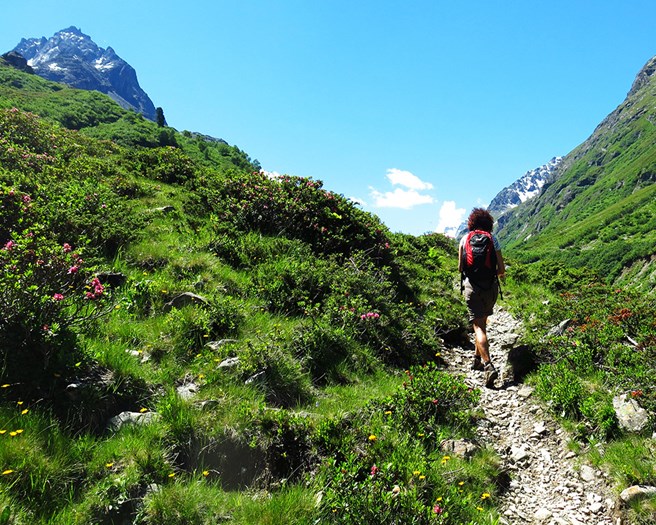
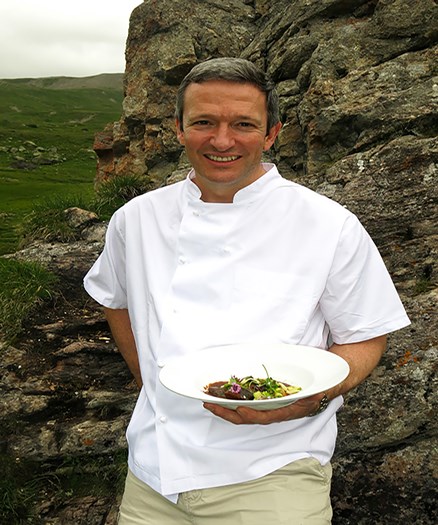
Above: You work up an appetite along the Culinary St. Jacob’s Way but great meals await from great chefs.
Certainly, this Alpine playground — it includes the villages of Ischgl, Galtur, Kappl and See — is at its busiest in the winter. It’s renowned for its lengthy ski season, which runs from November to the beginning of May, as well as an array of off-piste skiing opportunities and Ischgl’s legendary après-ski scene, where snow bunnies dance ’til dawn.
“But Ischgl isn’t only a party town,” insists Maritta Jungmann, a native I met who works for the tourist office. In the summer, she says, the area attracts an older crowd, as well as families, who come for hiking, biking (including increasingly popular electric bikes, with a wee motor to help you up the hills), climbing and bouldering. Bouldering, for the uninitiated (like me) is defined as “climbing without ropes at jumping height.” The village of Galtur has one of the largest boulder parks in Europe, with 160 of these behemoths. What little equipment you do need for bouldering — climbing shoes and the ominous-sounding “crash pads” — can be rented in Galtur.
The streets of Ischgl, which remain relatively quiet in the summer, are also lined with shops selling or renting all types of gear to help you work up a sweat, as well as restaurants and bars — usually fronted by a sunny terrace — where you can satiate an Alpine appetite. I was particularly surprised by the quality of food at the hotels, where I enjoyed artistically plated meals at the Hotel Tirol Alpin Spa, the Hotel Post, and the Hotel Trofana Royal, a five-star chalet-style property where blooming flowers festoon its expansive wooden balconies.
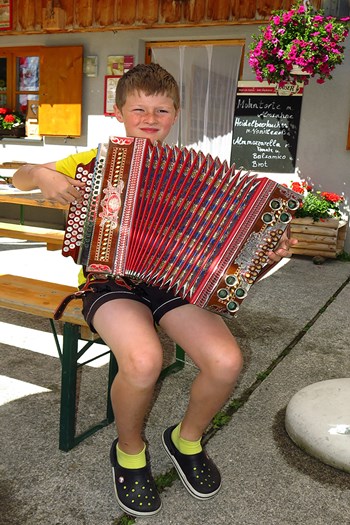
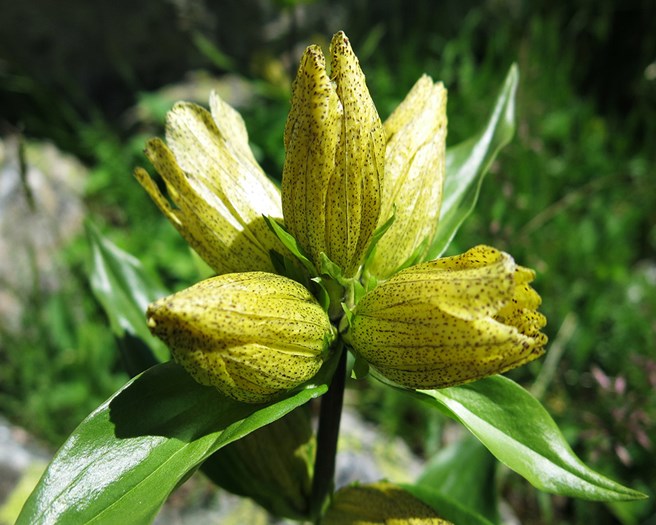
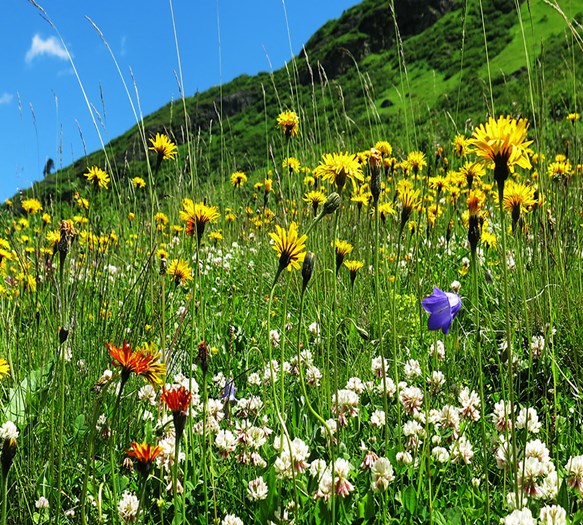
Above: Local music and some breathtaking Alpine scenery spurs people along the culinary trek.
Still, the gourmet highlight of the summer remains the Culinary St. Jacob’s Way, which is why I find myself hiking up the Jamtal Valley on a Sunday morning (last year) with Jungmann, a flock of fellow foodies, and the U.K.’s Stephen Crane, one of the featured Michelin-starred chefs of 2016. As it was the opening day of the event, Crane was making the trek to personally serve his dish at his assigned chalet, the Jamtalhutte, which lay at the end of a 10-kilometre-long ascent.
As much as I was looking forward to the meal, I also savour every slow step of the journey. It isn’t just the occasionally arduous incline which slackens my pace. It’s the stunning scenery, too. Pink Alpen roses and rainbow-hued wildflowers accent the valley’s lush green slopes, which tumble down to meet a clear, rushing stream that slices through its centre.
The rarest of these feral flowers is the enzian — also known as gentian — whose root is used to make an allegedly medicinal schnapps. Although we spot a few of these pale yellow blossoms along the path, Jungmann warns me not to pluck them, explaining that only 10 people, chosen by lottery from the village of Galtur are allowed to harvest them every year. Cheaper knock-off liqueurs made from a similar wildflower root abound, but one litre of genuine enzian schnapps sells for about 200 euros ($350 Cdn) — and that’s only if you can find someone willing to sell it to you.
If that sounds pricey, Jungmann maintains that it’s well worth the cost. “This schnapps, I tell you, it’s magic. When you feel you’re getting ill, you drink just a little bit,” she says. “You smell the earth, the grass. For me, it’s the essence of my home.”
Jungmann admits, however, that the liqueur isn’t to everyone’s taste. When she cheerfully pronounces the cow patties we have been dodging to be “the scent of the mountains,” I wonder if perhaps I’d prefer to sidestep the enzian, as well.
Following a brief, refreshing break at the Scheibenalm hut — a family-run summer restaurant in the foothills, where 9-year-old twins, Jakob and Lena Wurm perform an impromptu concert upon the accordion and the harp — we meet a trio of the cow patty culprits up close.
One of these bovine beauties seems to take a liking to me, offering a forceful nuzzle that triggers a cacophonous clanging from the bell tied around her neck. Alarmed, Jungmann cautions me to move along
“Maybe she just wants to play,” she says warily, “but remember, the cows are much bigger than you.”
Whatever the heifer’s true intentions, when we finally reach the Jamtalhutte overlooking the icy splendour of the Jamtal Glacier, I’m glad that I’m sitting down to Chef Crane’s beautifully braised pork cheeks, rather than a relative of the cow I just met.
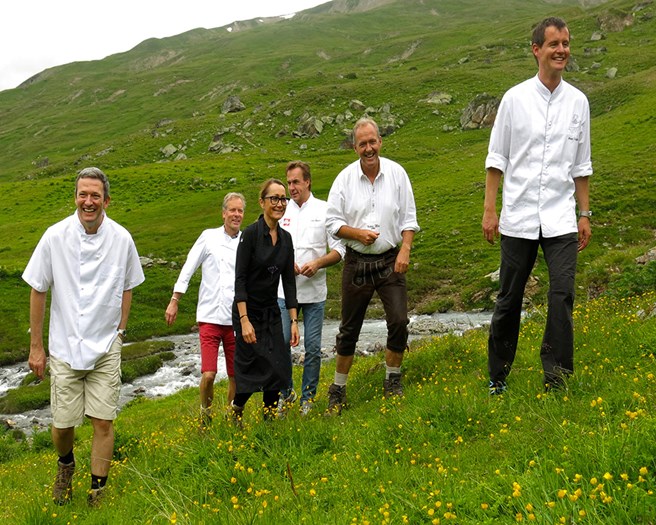
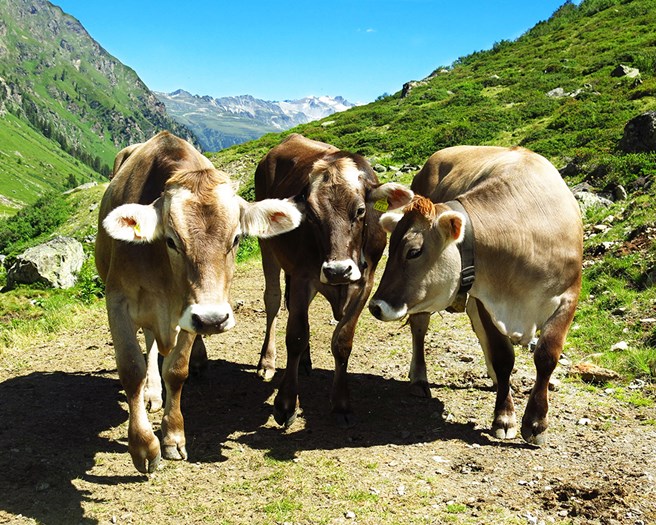
Above: Some of the world's great chefs participate in the event but you may face some roadblocks along the Way.
We must have been lulled into a mellow haze by a full belly and a mug or three of Alpine beer, because when Jungmann suggests at the end of the meal that we give her beloved enzian (or at least the imitation version) a shot, so to speak, we warily acquiesced.
“Zom, zom, zom, zom proooost!” we cried in unison, clinking our glasses high overhead, as Jungmann leads us in a traditional toast.
Tilting the tipple past my lips, I’m flooded by a sudden warmth. Sure, it could have been sunstroke. But then again, perhaps there really was some magic in that fluid, genuine or not, that encapsulates the flora and fauna of the valley that charms me at every twist and turn.
About the Author
As a UK-based writer and photographer (and self-confessed natural coward attempting to conquer her fears through her travel adventures), Amy Laughinghouse has paraglided 007-style in the Swiss Alps, walked with lions in Mauritius, swum with sharks in French Polynesia, dangled from chains on Scotland's Fife Coastal Path, and--her most terrifying challenge ever--taken ballroom dance lessons in London. In addition to her own website, AmyLaughinghouse.com, she has contributed to many travel publications, including LonelyPlanet.com, Qantas Airlines’ in-flight magazine and Virtuoso Life magazine.